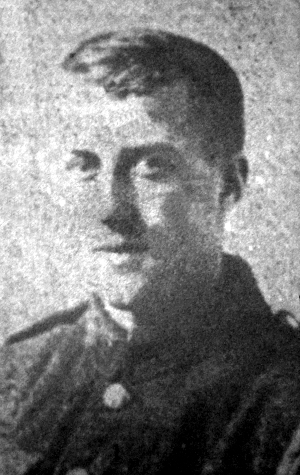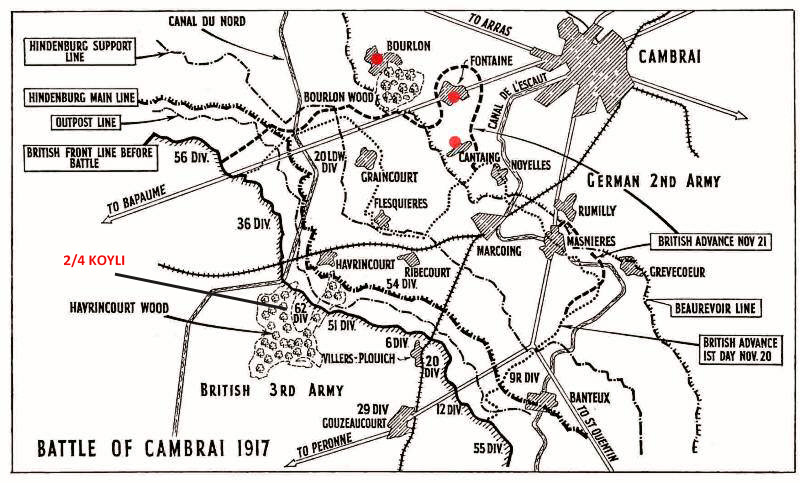
John Marsden Lucas was born on the 24th December 1893, the first child and elder son of Ossett plumber and painter Albert Lucas and his wife, Sarah Jane (nee Marsden), of Gawthorpe, who married at Ossett Holy Trinity Church on the 3rd August 1893. The couple had four children, but one child died before April 1911. John Marsden Lucas was baptised on the 6 May 1894 at Dewsbury All Saints Church.
In 1901, Albert and Sarah Lucas were living on Station Road, Ossett with their sons. Albert Lucas died in June 1907, aged 46 years and by 1911 his widow Sarah Jane was living at Barmby Fold, Manor Road, Ossett with her two sons and a daughter, Norah aged 7. John Marsden Lucas was now aged 17 and his brother, Donald, was 7 years old. At this time, John Lucas was working as a coal cleaner.
John Marsden Lucas’s army service record has not survived, but it is known that he enlisted in Ossett, and that he served with the Volunteer Force before the declaration of War on 4th August 1914. He was then serving with the King’s Own Yorkshire Light Infantry with service no. 5210 and subsequently served with 2/4 KOYLI (service no. 203212), embarking with his regiment for Le Havre on the 15th January 1917.
Private Lucas died of his wounds in a hospital at Rouen on the 23rd November 1917. In 1920, John’s next-of-kin was recorded as his uncle, Wilson Briggs of ‘Hillcrest’, Walton, Wakefield. John Marsden Lucas was posthumously awarded the British and Victory medals.
The Territorial 2nd/4th Battalion, KOYLI was formed at Wakefield on the 30th September 1914 as a second line unit. On the 1st March 1915 they moved to Bulwell and were attached to 187th Brigade in 62nd (2nd West Riding) Division. They moved in April 1915 to Strensall and in May to Beverley, going on in November to Gateshead, in January 1916 to Larkhill and in June 1916 to Flixton Park near Bungay. They moved again in October 1916 to Wellingborough and landed at Le Havre, France on the 15th January 1917.
It is likely that Private John M. Lucas was wounded during intense fighting at the Battle of Cambrai, between the 20th November and the 6th December 1917. On the 20th November, the opening day of the battle, 62 Division broke through both the Hindenburg Main and Support Lines, occupying Havrincourt and Graincourt, and by the end of the day had crossed the Bapaume to Cambrai road (N30). This represented an advance of 7 km in one day, an outstanding achievement at that time. The next day the division took Anneux and the tanks entered Bourlon Wood, but the infantry were too exhausted to follow them.
The effort was aimed at Bourlon Ridge. Fighting was fierce around Bourlon and at Anneux (just before the woods) was costly. German counter-attacks squeezed the British out of Moeuvres on the 21st November and Fontaine on the 22nd November; when Anneux was taken, the 62nd Division found themselves unable to enter Bourlon Woods. The British were left exposed in a salient. Haig still wanted Bourlon Ridge and eventually the exhausted 62nd Division was replaced by the 40th Division.
The “Ossett Observer” 1 had a short obituary for John Marsden Lucas:
“Ossett Machine-Gunner’s Fate – The sad news was received this week by Mrs. A. Lucas, widow, of Barmby-fold, off Manor-road, South Ossett, that her son, Lewis-gunner Jack Marsden Lucas (23), of the K.O.Y.L.I. had been admitted to hospital on the 22nd November, suffering from a gun-shot wound in the lower part of the body, and died the following day. Before joining the army the deceased worked as an engineer at Messrs. Jonas Glover, Ltd., Westfield Mill, Ossett.”

Private John Marsden Lucas, aged 23 years, brother of Miss Norah Lucas, of ‘Hillcrest’, Walton, Wakefield, died on the 23rd November 1917. He is buried at grave reference P. III. T. 2A. at the St. Sever Cemetery Extension, Rouen, 2 Seine-Maritime, France. St Sever Cemetery and St. Sever Cemetery Extension are located within a large communal cemetery situated on the eastern edge of the southern Rouen suburbs of Le Grand Quevilly and Le Petit Quevilly.
During the First World War, Commonwealth camps and hospitals were stationed on the southern outskirts of Rouen. A base supply depot and the 3rd Echelon of General Headquarters were also established in the city.
Almost all of the hospitals at Rouen remained there for practically the whole of the war. They included eight general, five stationary, one British Red Cross and one labour hospital, and No. 2 Convalescent Depot. A number of the dead from these hospitals were buried in other cemeteries, but the great majority were taken to the city cemetery of St. Sever. In September 1916, it was found necessary to begin an extension, where the last burial took place in April 1920.
The cemetery extension contains 8,348 Commonwealth burials of the First World War (ten of them unidentified) and in Block “S” there are 328 from the Second World War (18 of them unidentified). There are also 8 Foreign National burials here.
References:
1. “Ossett Observer”, 1st December 1918